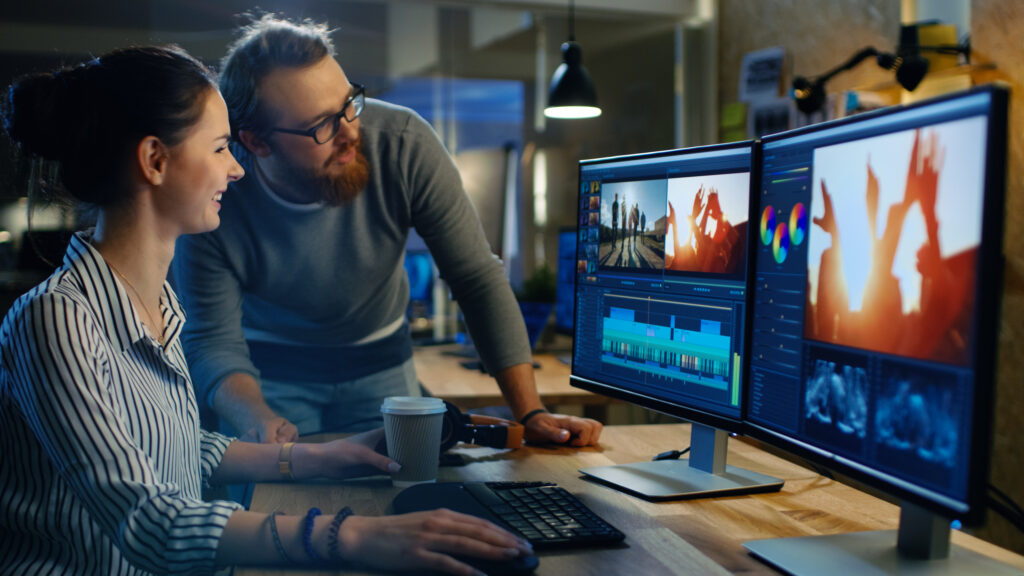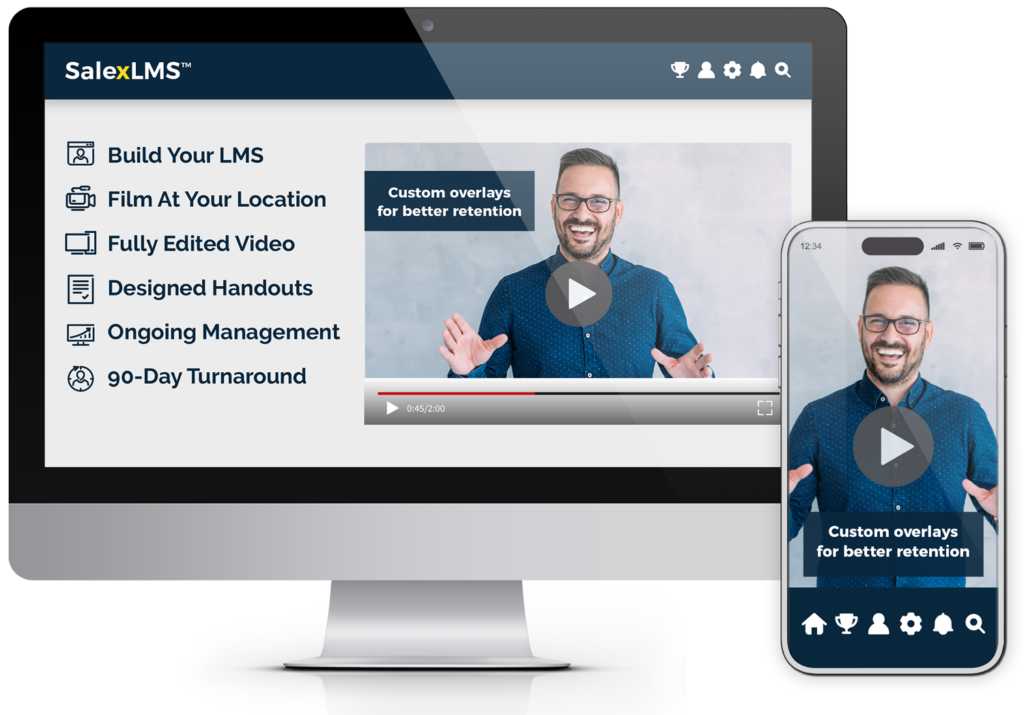This is everything you need to know about video-based learning management systems (LMS). Video-based Learning Management Systems (LMS) are at the forefront of transformation. This technology leverages the power of visual learning to make educational content more engaging and accessible.
At the helm of this revolution is SalexLMS, a platform distinguished by its robust features and innovative approach.
This comprehensive article explores how video-based LMS like SalexLMS reshape learning environments in schools and corporations.
The Rise of Video-Based Learning
The digital age has ushered in a paradigm shift in how information is consumed. Visual media, particularly video, dominates learning preferences due to its ability to convey complex information in a digestible format. According to a Cisco forecast, video will account for 82% of all internet traffic by 2022.
This trend highlights the growing preference for video as a primary source of information and learning. In educational settings, video-based learning enhances engagement by allowing learners to visualize concepts and processes, which can be particularly beneficial in science, engineering, and the arts.
Video-Based Learning is Effective
Video-based learning stands out as one of the most effective educational tools because it captures and retains the learner’s attention while simplifying complex information. The visual and auditory stimulation offered by videos caters to multiple learning styles, particularly visual and auditory learners, by presenting content dynamically and engagingly.
This multi-sensory approach is crucial in enhancing memory retention and understanding. Videos can demonstrate procedures, narrate processes, and show real-life applications of theoretical concepts, making them particularly effective for subjects that benefit from visual representation, such as science experiments, mechanical operations, and more.
Use Storytelling Techniques To Engage Viewers
Moreover, using storytelling elements and scenarios within videos can help create a contextual and emotional connection with the material, further embedding the learning in the student’s memory.
Additionally, video-based learning provides flexibility and control over the pace of learning, which is vital for accommodating individual learning speeds and schedules. Learners can pause, rewind, and rewatch video segments as needed, ensuring they fully understand the content before moving forward.
This self-paced nature of video learning reduces the pressure and anxiety associated with traditional classroom settings. It allows learners to engage with the material at their most effective learning times.
Here are two statistics that support the effectiveness of video-based learning:
- Increased Retention Rates: Research shows that retention rates for video-based content can reach 65%, compared to only 10% for reading text. This significant difference highlights how video as a medium can more effectively imprint information in the learner’s memory due to its dynamic combination of visual and auditory stimuli (Source: The Research Institute of America).
- Preference and Engagement: According to a survey by the eLearning Industry, 95% of learners responded better when they used video in their training. This statistic underscores learners’ strong preference for video, which translates into higher engagement levels compared to traditional text-based educational methods. Higher engagement is directly linked to improved learning outcomes, demonstrating the practical benefits of incorporating video into learning environments.
Videos are also easily accessible on various devices and platforms, supporting learning in formal educational settings and in remote and informal environments. This accessibility, combined with the engaging format of videos, broadens the reach of educational opportunities and supports continuous learning and development.
Hence, video-based learning is not just a tool for information delivery; it is a comprehensive approach that enhances understanding, retention, and accessibility, making it exceptionally effective across diverse educational needs.
Understanding Learning Management Systems (LMS)
Learning Management Systems are sophisticated platforms designed to deliver educational courses and training programs effectively. They act as the backbone of eLearning, enabling the creation, management, and delivery of business content, tracking learner progress, and fostering collaboration among employees and trainers.
As educational institutions and businesses increasingly adopt eLearning strategies, LMS platforms like SalexLMS are becoming indispensable tools in their digital transformation journeys.
Why Video-Based Learning Management Systems?
A video-based LMS offers several advantages over traditional text-based platforms. These systems cater to the modern learner’s preferences for fast-paced, multimedia learning experiences that are engaging and flexible.
For instance, SalexLMS includes features like adjustable playback speed, interactive transcripts, and mobile compatibility, allowing learners to access educational content on-the-go and according to their learning pace and style.
SalexLMS: A Leader in Managed Video-Based Learning Management Systems
SalexLMS sets itself apart with its comprehensive video-based learning tools designed for maximum engagement and retention.
For example, a multinational corporation implemented SalexLMS to train its global workforce on new software. Incorporating interactive video tutorials led to an 80% improvement in software proficiency within three months—a testament to the platform’s efficacy. SalexLMS streamlines the learning process and provides analytics that help educators and corporate trainers improve their content continuously.
Integrations and Compatibility of a Video-Based Learning Management Systems
SalexLMS supports many integrations with other software systems, enhancing its utility as a centralized learning platform. This compatibility includes seamless connections with ERP systems, marketing tools, and advanced analytics platforms. These integrations allow organizations to leverage a holistic data and learning management approach, enhancing learner engagement and organizational efficiency.
Selecting the right LMS is crucial for any learning program’s success. SalexLMS represents the pinnacle of video-based LMS solutions, offering unparalleled features that enhance learning outcomes and operational efficiencies. Its commitment to innovation and quality makes it an ideal choice for educational institutions and businesses investing in a top-tier LMS.

Enhancing Video Production for Learning Management Systems
High-quality video production is essential for effective video-based learning. The quality of your videos can significantly impact learners’ engagement and retention rates.
We recommend using this guide to get started with gear, project management, and keeping your sanity during this process.
Here are vital aspects to consider when producing videos for platforms like SalexLMS:
Choosing On-Camera Personalities
The presenter or on-camera personality can significantly influence learner engagement. Choose presenters knowledgeable about the subject and have a good on-camera presence. They should be able to communicate clearly and engagingly. It’s often beneficial to use presenters who are practiced educators or have a background in teaching, as they understand how to convey information effectively and keep learners interested.
Choosing the Right Background Environment for Video
The choice of background can set the tone and context of your educational videos. A clean, uncluttered background is typically best as it minimizes distractions and keeps the focus on the content and the presenter. For professional-looking videos, consider using a green screen. This allows you to superimpose any digital backdrop that fits the lesson’s theme, ranging from a simple solid color to more elaborate educational graphics.
Lighting
Good lighting is crucial for producing clear and engaging videos. Natural light is ideal, but it can be unpredictable and inconsistent. Therefore, investing in good-quality studio lights can make a significant difference. Key light, fill light, and backlight—collectively known as three-point lighting—are standard setups to achieve a well-lit subject with depth and minimal shadow.
Camera Choice
The choice of camera can affect the visual quality of your videos. While high-end professional cameras provide excellent quality, they can be expensive and require skilled operation. Many mid-range cameras, including DSLRs and mirrorless cameras, offer great video quality at a more accessible price point. Ensure the camera supports HD or 4K resolution to future-proof your content and cater to screens of all sizes.
Microphones
Audio clarity is just as important as video quality. Poor audio can detract from the learning experience, no matter how good your video looks. Lapel microphones are great for capturing clear speech as they can be placed close to the speaker’s mouth. For a more flexible setup, consider high-quality shotgun mics, which can capture clear audio from a distance without intruding into the shot.
By focusing on these aspects of video production, organizations can significantly enhance the quality of their educational offerings on video-based LMS platforms like SalexLMS. These improvements enrich the learning experience and reinforce the academic institution’s commitment to providing high-quality learning materials.
Use Camera Movement to Engage Viewers.
Using camera movement effectively can significantly enhance the immersive quality of educational videos, drawing viewers deeper into the learning process. Dynamic camera movements, such as panning, tilting, or zooming, can make video content more engaging by mimicking natural human observation and adding a sense of space and context.
For instance, a slow pan across a historical artifact can simulate the experience of examining it in a museum, making the viewer feel as though they are there. Similarly, zooming in can highlight essential details or features, helping to focus the learner’s attention on specific aspects of a lesson. By varying camera angles and employing thoughtful movements, educators can create a more interactive and stimulating visual environment that maintains the viewer’s interest and enhances their understanding and retention of the material.

Editing Training Videos For Better Engagement with Video-Based Learning Management Systems
Adapting Video Content for Multiple Viewing Platforms
In today’s multi-device world, video-based learning systems like SalexLMS must cater to learners’ diverse viewing preferences and habits. Providing both horizontal and vertical video options can significantly improve the accessibility and effectiveness of educational content.
Horizontal Videos for Video-Based Learning Management Systems
Horizontal or landscape videos are traditionally preferred for desktop viewing as they match the natural aspect ratio of most computer screens. This orientation is ideal for detailed educational content where a broader view is necessary to display complex information or diagrams or when featuring multiple on-screen elements. Horizontal videos are also beneficial for group viewing settings or desktop users with larger screens, where a wider field of view can enhance the collective learning experience.
Vertical Videos for Video-Based Learning Management Systems
With the increasing use of mobile devices for learning, vertical or portrait videos have become important. Many users hold their phones upright most of the time, and vertical videos cater to this habit, making it easier for mobile learners to engage with content without needing to rotate their devices. This orientation is efficient for direct-to-camera speaking, allowing the presenter to connect more intimately with the audience, mimicking face-to-face interaction. Vertical videos are crucial for microlearning segments or quick tutorials that learners might want to access on the go.
By following these steps, you can create training videos that are not only informative but also engaging and easy to digest. Remember, the goal is to keep the viewer engaged while providing them with the essential information they need to move on to the next topic efficiently. With practice, your video editing skills will improve, enhancing the quality of your educational content.

Setting Up Video-Based Learning Management Systems
Implementing a Learning Management System (LMS) is a strategic and transformative process that can significantly enhance how educational programs are delivered, tracked, and managed within an organization. Whether for employee training, compliance, or academic teaching, the steps involved in setting up an LMS require careful planning and execution to ensure success. Here is an enriched guide on how to properly set up an LMS, complemented by best practices and expert insights:
Step 1: Define Your Objectives
The first step in deploying an LMS is to define your objectives clearly. What are your primary goals for this system? Whether improving employee performance, ensuring compliance, enhancing student engagement, or extending training to external stakeholders, having a clear set of objectives will help guide all subsequent decisions.
Expert Tip: Engage stakeholders across your organization to establish these goals to ensure the LMS meets diverse needs.
Step 2: Assess Technical Requirements
Understanding the technical infrastructure of your organization is crucial. This includes evaluating your current IT setup, internet reliability, hardware availability, and scalability options for future growth. Consider the user base and their technological proficiency. Will the LMS need to support thousands of users simultaneously? Does it need to integrate with existing HR or ERP systems? These considerations will guide you in choosing an LMS with the appropriate technical specifications.
Step 3: Evaluate Features and Functionality
Compile a list of essential features that support your educational goals:
- Course Management: Tools for creating, importing, and managing course materials interactively.
- User Management: Capabilities to segment users into groups, manage permissions, and track progress.
- Assessment Tools: Automated tools for testing and feedback collection.
- Communication Tools: Integrated tools such as message boards, instant messaging, and email to facilitate interaction.
- Analytics and Reporting: Detailed reporting tools to track user progress, engagement, and completion rates.
- Accessibility Features: Compliance with standards like WCAG to ensure all learners can use the system effectively.
Step 4: Choose a Vendor
Choosing the right vendor is pivotal. Look for providers with robust security measures, dependable customer support, and positive testimonials from similar industries or needs.
Request live demos, pilot programs, or trial periods to see the LMS in action. Consider the vendor’s history of updates and support to ensure they are future-proofing their technology.
Done-for-You Verses Do-it-Yourself LMS Platforms
A sales enablement specialist constantly challenges ensuring that sales teams have the right skills and knowledge to drive results. Working with a fully managed, done-for-you video-based Learning Management System (LMS) can significantly streamline this process, offering numerous advantages over a do-it-yourself (DIY) platform.
A fully managed LMS is specifically designed to reduce the workload on sales enablement teams by handling all aspects of the LMS operations, from the technical setup and maintenance to content management and updates. This allows specialists to focus more on strategic tasks such as content creation, sales training techniques, and performance analysis rather than getting bogged down with the technical complexities of managing the LMS infrastructure.
Furthermore, these systems often come with expert support and consultancy, ensuring that the LMS is continuously optimized for the best possible learning outcomes and is updated with the latest educational technologies and methodologies.
Fully Managed Video-Based Learning Management Systems is Typically Higher Quality And Better Performing
Additionally, a fully managed video-based LMS typically provides a higher quality of service regarding the technology used and the learning experience offered. These platforms have sophisticated tools and features designed to engage modern learners, such as interactive video content, gamification, and real-time analytics.
This not only enhances the learning experience but also provides detailed insights into user engagement and effectiveness, enabling sales enablement specialists to tailor training programs more accurately to meet the sales team’s needs.
DIY Video-Based Learning Management Systems Are A Major Time Investment And Costly
In contrast, DIY platforms often require a steep learning curve and substantial time investment to achieve similar results, and they may lack advanced features and the level of customization that a fully managed service offers.
Therefore, for sales enablement specialists looking to maximize efficiency and impact in their training efforts, investing in a fully managed video-based LMS is a strategic decision that can lead to significant advantages in terms of time management and training effectiveness.
Step 5: Plan the Implementation Process
Create a detailed implementation roadmap that includes key milestones, such as system configuration, content migration, pilot testing, user training, and the official launch. Assign roles and responsibilities to ensure clear accountability throughout the process.
Industry Insight: Successful LMS implementations often involve phased rollouts, allowing adjustments based on user feedback and system performance.
Step 6: Migrate Data and Integrate Systems
Data migration is a critical phase. Plan for a seamless course materials, user data, and historical records transition. Ensure that data integrity is maintained and all data is backed up before migration. System integration can range from simple API connections to complex custom coding, depending on the LMS and existing IT infrastructure.
Step 7: Test the System
Conduct comprehensive testing of the LMS to ensure every feature works as intended. This includes system functionality, user interface accuracy, and compatibility with various devices and browsers. Load testing is crucial to determine if the system can handle the expected number of simultaneous users.
Step 8: Train Your Team
Develop a training program tailored to your organization’s different user groups. Use various training methods, such as live training, webinars, and self-paced tutorials. Provide ample support materials like user manuals, FAQ sections, and helpdesk support.
Step 9: Launch and Monitor
After a successful pilot phase, launch the LMS to all users. Monitor the system closely to address any technical issues quickly. Solicit ongoing feedback to gauge user satisfaction and identify areas for improvement.
Step 10: Evaluate and Iterate
Regularly evaluate the LMS against your initial objectives and key performance indicators (KPIs). Use the data collected through analytics to understand usage patterns and user satisfaction, making adjustments as needed. Regular updates and continued support from the vendor are vital to keeping the LMS current and effective.

The importance of aesthetics for your video-based learning management system
Many traditional Learning Management Systems (LMS) come with an out-of-the-box user interface that often leaves much to be desired. These platforms typically prioritize functionality over form, resulting in interfaces that can be clunky, outdated, and not particularly user-friendly.
The visual aesthetics are usually minimalistic and utilitarian, which, while potentially reducing distractions, can also make the learning experience somewhat monotonous and disengaging. The lack of intuitive design and visual appeal can lead to reduced engagement among learners, who may find the platform uninspiring and tedious to navigate.
SalexLMS has an aesthetically pleasing user interface
In contrast, SalexLMS distinguishes itself with a modern, aesthetically pleasing user interface that elevates the learning experience. Recognizing that a visually appealing environment can significantly enhance engagement and motivation, SalexLMS has invested in an attractive and functional design.
The platform features a contemporary look with clean lines, a coherent color scheme, and intuitive navigation, making it easy and enjoyable for users to interact with the system. This attention to design detail ensures that learners are drawn into the content and enjoy a seamless learning journey that feels modern and aligned with the best user experience practices in other leading software applications.
The engaging user interface of SalexLMS does more than attract the eye—it makes the learning process more enjoyable and effective. By combining aesthetic appeal with user-friendly functionality, SalexLMS helps maintain high levels of learner engagement, reducing the fatigue and frustration that can often accompany using more traditional LMS platforms.
The improved interface supports better interaction with content through features like drag-and-drop functionalities, customizable dashboards, and interactive elements that make learning dynamic and immersive. As a result, teams benefit from the substantial educational tools SalexLMS provides and enjoy the process, leading to higher satisfaction and better educational outcomes.
Responsive Design in Video-Based Learning Management Systems
To fully support both video orientations, SalexLMS incorporates responsive design principles, ensuring videos automatically adjust to fit the screen size and orientation of the device being used. This flexibility enhances the user experience by providing optimal viewing conditions, regardless of how the viewer accesses the content. Moreover, SalexLMS can store and stream both types of video orientations, allowing content creators to design courses that are both pedagogically effective and highly accessible.
By integrating horizontal and vertical video options, SalexLMS ensures that all learners, whether using desktops or mobile devices, receive a seamless and engaging educational experience. This adaptability meets modern viewing preferences and sets a standard for accessibility in digital education platforms.
Incorporating Gamification into Video-Based Learning Management Systems
Gamification introduces game design elements into non-game environments, such as education, to enhance user engagement and motivation. In video-based LMS like SalexLMS, gamification can be implemented through points, badges, leaderboards, and challenges incorporated into video content. This approach helps sustain learner interest and encourages continual progress. For instance, learners could earn badges for completing video modules or points for passing quizzes embedded in video lessons. The competitive element can be further enhanced by displaying a leaderboard within SalexLMS, fostering community and user motivation.
Embracing Microlearning in Video-Based Learning Management Systems
Microlearning involves delivering content in small, specific bursts that are easier to digest and remember. Microlearning can transform traditional, lengthy training sessions into concise, focused video segments that cover a single topic or task when applied to video-based LMS. SalexLMS can enhance user experience by allowing educators to create short, engaging video lessons that learners can consume on their schedule, ideal for busy professionals or students in higher education. These bite-sized lessons can help improve retention rates and make learning less overwhelming.
Facilitating Social Learning Through Video-Based Platforms
Social learning theory suggests that people learn from one another through observation, imitation, and modeling. SalexLMS can support this by integrating features that allow learners to interact with peers and instructors. Discussion boards, video comments, and group projects facilitated through video can enrich the learning experience. By enabling learners to ask questions, share insights, and collaborate on assignments directly within the video-based LMS, SalexLMS supports knowledge acquisition and builds a collaborative learning community.
Optimizing Video-Based LMS for Mobile Learning
Mobile learning enables students to access educational content from their smartphones or tablets, providing flexibility to learn anytime and anywhere. SalexLMS should be optimized for mobile devices, ensuring the video content is accessible and performs well on various devices with different screen sizes. This includes adaptive streaming, touch-friendly interfaces, and downloadable content for offline viewing. Mobile learning support is essential for accommodating the modern learner’s mobile lifestyle, making education more accessible and convenient.
Implementing Immersive Learning with Advanced Technologies
Immersive learning uses virtual reality (VR), augmented reality (AR), and mixed reality (MR) to create a deeply engaging learning environment. SalexLMS could incorporate immersive elements in its video-based courses, where learners can, for example, enter a VR environment to experience historical events firsthand or use AR to overlay data on physical objects during an educational video. This approach can significantly enhance the learning process, making complex concepts simpler and more tangible.
Personal Experience and Further Considerations for Video-Based Learning Management Systems
As someone who has interacted with various LMS platforms, I can tell you that integrating these advanced learning strategies in SalexLMS significantly enhances the user experience. From personal experience, gamification and microlearning have proven especially effective in maintaining engagement and improving knowledge retention.
Furthermore, when considering these strategies, it’s essential to consider accessibility and inclusion. Ensuring that all learning content is accessible to people with disabilities, such as providing captions for videos and voice commands for navigating VR environments, is crucial. Data privacy and security should also be top priorities, especially when implementing social and mobile learning functionalities.
Setting up an LMS is a substantial investment in time and resources, but when done correctly, it can significantly enhance the effectiveness of your educational programs. By following these steps, you can ensure your LMS strategy’s smooth implementation and ongoing success.

Incentives to Engage Learners with Video-Based Learning Management Systems
Offering incentives to sales reps who are leaders in their company is an effective strategy to motivate performance, boost morale, and retain top talent. Here are ten incentives that can reward and encourage these high achievers:
- Monetary Bonuses: Rewarding top performers with cash bonuses for exceeding sales targets is a straightforward and highly appreciated incentive.
- Commission Increase: Higher commission rates for surpassing goals can drive continued high performance and loyalty.
- Profit Sharing: Allowing leading sales reps to share in the profits they help generate can deepen their commitment to company success.
- Paid Trips and Vacations: Rewarding top achievers with all-expenses-paid vacations or trips to exotic destinations as a recognition of their hard work and success.
- Exclusive Club Memberships: Providing memberships to exclusive clubs, such as golf clubs or executive lounges, as a perk for top performers.
- Stock Options: Granting stock options enables sales leaders to benefit directly from the company’s growth that they help drive.
- Professional Development Opportunities: Offering opportunities for further education, such as advanced sales training programs, conferences, or workshops, to foster career growth and development.
- Flexible Work Options: Giving top performers more flexibility in their work schedules or the option to work remotely as a recognition of their ability to manage time and deliver results independently.
- Recognition Programs: Implementing formal recognition programs that spotlight top performers company-wide, enhancing their professional reputation and validating their efforts.
- Premium Health and Wellness Benefits: Enhancing health and wellness benefits, such as private health insurance, gym memberships, or spa vouchers, to support their overall well-being and job satisfaction.
These incentives reward top performers and motivate other team members to strive for excellence, fostering a more competitive and results-driven sales environment.


